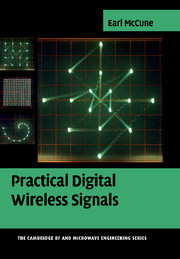Book contents
- Frontmatter
- Contents
- Preface
- Definitions and acronyms
- Terminology and notation
- 1 Keying, states, and block diagram construction
- 2 Common issues and signal characterization
- 3 Important details on results from Shannon, Nyquist, and others
- 4 Digital amplitude modulation (ASK)
- 5 Digital frequency modulation: FSK
- 6 Digital phase modulation: PSK
- 7 Combined digital modulations: QAM and OFDM
- 8 Spread spectrum
- 9 Wireless propagation and antenna fundamentals
- 10 Principles of coding
- 11 Multiple access techniques
- 12 Signal tradeoffs and system evolution
- Tutorial Appendices
- Index
- References
12 - Signal tradeoffs and system evolution
Published online by Cambridge University Press: 04 August 2010
- Frontmatter
- Contents
- Preface
- Definitions and acronyms
- Terminology and notation
- 1 Keying, states, and block diagram construction
- 2 Common issues and signal characterization
- 3 Important details on results from Shannon, Nyquist, and others
- 4 Digital amplitude modulation (ASK)
- 5 Digital frequency modulation: FSK
- 6 Digital phase modulation: PSK
- 7 Combined digital modulations: QAM and OFDM
- 8 Spread spectrum
- 9 Wireless propagation and antenna fundamentals
- 10 Principles of coding
- 11 Multiple access techniques
- 12 Signal tradeoffs and system evolution
- Tutorial Appendices
- Index
- References
Summary
Having discussed many characteristics of individual signal types in Chapters 4 through 7, here we compare these signals to illustrate the tradeoffs involved in selecting among them. Every DWC application must be considered on its own merit and constraints, and history makes it very clear that there is not one universally acceptable signal type that is best for all applications.
At the heart of all applications it is usually cost which strongly influences the ultimate design of a DWC system. But even here, the definitions of cost are not universally applicable. It has become my experience that an optimum design for any DWC application is best achieved by a process of successive cost vs. benefit analyses. This I call the Keep it Simple method of DWC design. Every additional capability of a DWC system comes at a cost to implement it – nothing comes for free. The best overall design results from a careful analysis which achieves the maximum desired benefit at a reasonable cost.
Following this Keep it Simple (KIS) process, a design team always begins with a minimum total cost design, which is based on the OOK signal as discussed in Section 12.4. IF this design successfully meets all system objectives, then we are finished. If not, then we identify the characteristics which are not met with this design and estimate the cost to the application's missing capability in not meeting that characteristic.
- Type
- Chapter
- Information
- Practical Digital Wireless Signals , pp. 320 - 340Publisher: Cambridge University PressPrint publication year: 2010



